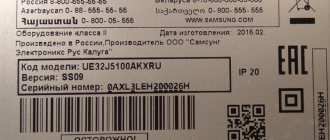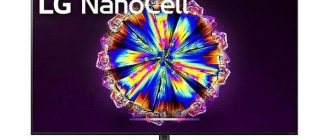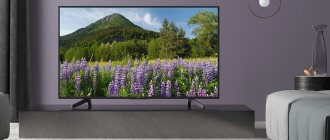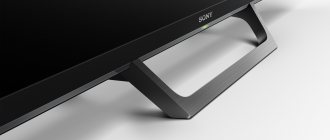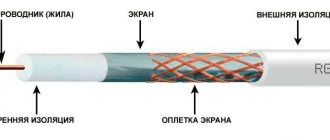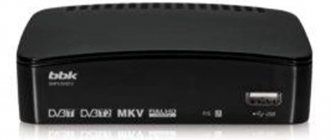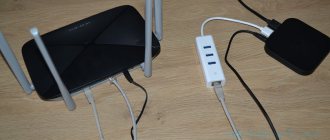There is a huge improvement in technology in modern TVs.
Starting with cathode ray tube (CRT) televisions, we moved to liquid crystal display (LCD) and then to light emitting diodes (LED).
Today, you have new advanced concepts of both organic light ( OLED ) and quantum dot ( QLED ) that drive TV technology.
This has led to television viewing reaching a very high level that no one could have imagined before.
This article attempts to shed light on the QLED technology patented by Samsung Inc. and looks at some of the best Samsung QLED, LED TVs offered today.
What is the difference between monitors on Samsung TVs?
Before diving into the details of QLED and how it compares to LED, let's briefly discuss the basic functionality of LED/LCD monitors.
Traditional LCD TVs have a display panel and a backlight option to make pictures visible. This happens because LCDs do not produce light on their own. They produce images when you pass electricity through them. You need a specific light source to make your images stand out.
LED is more efficient than CFLs. So, what you see nowadays as an LED TV is nothing more than an LED-backlit LCD monitor.
What is the difference between Samsung LED and OLED TV
The world is shifting towards organic materials.
We have organic food, organic soaps and shampoos. Therefore, it should not be a surprise if we have an OLED concept.
OLED displays are significantly different from LED-backlit LCD TVs. LCD TVs work on transmission technology, while OLED TVs work on emissive technology.
The difference is that OLED displays are able to generate and illuminate images, unlike the LCD-LED combination.
OLED TVs do not require an external light source. This allows them to produce varying degrees of contrast levels that are otherwise impossible to achieve with LED backlighting.
Therefore, the general statement is that OLED displays are much better than traditional LED-LCD TVs.
Backlight type
All TVs, except those using OLED technology, use LED matrix backlighting. Now manufacturers are implementing two directions: Edge LED and Direct LED. In the first case, the LEDs are located around the perimeter of the screen, but the matrix itself is illuminated by a diffusion panel. This option is quite cheap and allows you to create a thin body.
In Direct LED, the LEDs are located behind the matrix itself, distributed evenly over its entire area. This design is thicker, but it allows you to achieve uniform illumination without obvious highlights. In addition, this technology allows you to extinguish the desired areas of the screen, which provides a more natural and deep black color.
What is the difference between Samsung LED and QLED TV
QLED is a patented concept of Samsung Inc.
Touted as being similar or even superior to the LED concept, a QLED TV is still very much an LED-backlit LCD TV.
Read: OLED vs QLED, compare technologies and choose the best TV
This doesn't mean the technology is worse.
Quantum dots are nanoparticles that can emit and change light at different frequencies when you expose them to electricity. The functionality is very similar to an LED-LCD TV, but of higher quality. However, the fact remains that this is a transmission technology. In this sense, it differs from OLED TVs.
Extended Warranty: Don't Waste Your Money
Stores literally pray for extended warranties - you don’t have to do anything, and the money flows like a river. No, it’s true - TVs, of course, are no longer as reliable as before, but they will work quietly for 5-10 years, and if something does break, it will be more likely during the first warranty year than later. Most components, including the same LEDs, have good survivability. So don’t waste your money - it’s better to use it to buy something more necessary (for example, a bracket).
Select and buy a TV bracket
Which OLED and QLED technology is better?
That's a very difficult question. OLED technology is an older technology used by many TV and smartphone manufacturers, including Samsung, while QLED is a proprietary technology currently used only by Samsung Inc.
Both are excellent as they provide the deepest range of colors.
Both types of TVs support high dynamic range (HDR) content and have 4K resolution.
A wide range of companies offer OLED screens on their smartphones. There are also Samsung Galaxy smartphones that display this technology. As for QLED, they haven't made screens that small yet.
OLED technology can produce the very best black levels, so critical in any screen technology. The darker the black, the more accurate the image quality. This increases the contrast ratio to very high levels, thereby providing a more attractive picture quality.
OLEDs themselves are a light source and hence they turn off the corresponding pixels when the image needs a black backlight. Hence, you get perfect blacks in OLED. As for QLEDs, they must depend on the LED for the light source.
Therefore, there is a chance for some colors to bleed through the panels, thus creating an extremely good, but not so perfect black.
What do we know about 4K?
Rumors around 4K began to actively gather in 2012, when the resolution began to slowly develop. It was interesting both to large companies for which it is important to constantly develop something new, and to ordinary users who want to constantly receive something new. LG did not stand aside, presenting the first 3D TV with 4K UHD at one of the 2012 exhibitions.
And other manufacturers who work with TVs and other multimedia devices tried to show something with 4K at such exhibitions.
Even then, one could talk about the imminent success of the new resolution, just looking at the admiring faces of visitors who froze in front of the ultra-high definition screens. But just 5 years ago, not everyone could afford a 4K TV. We had to wait a little.
4K resolution replaced the not so popular 2K, which followed Full HD. Most users, by the way, missed 2K due to the rapid appearance on the market of a more formidable competitor in the form of 4K. 2K today is increasingly used by some companies when developing displays for smartphones - models for those for whom Full HD is no longer enough on a mobile device.
The key difference between 4K and its predecessors, as you might guess, is greater resolution (a value that determines the number of dots (pixels) per unit area). So 4K exceeds 2K by approximately two times in width and height, and Full HD by 4 times. However, there is no single image resolution in pixels for 4K, so there are 6 standards. Among them are:
- Full frame 4K. The standard, which, in fact, reflects the 4K resolution in pixels - 4096 × 3072. However, it is not very common.
- Academic 4K. This standard is gaining wide popularity among film studios; ordinary users simply do not need it in their usual devices - 3656x2664 pixels.
- Cased 4K. Another type of cinema standard, which has a different aspect ratio. It has a similar resolution – 3996×2160 pixels.
- DCI 4K. Standard used in cameras. More and more modern smartphones support it, the resolution is 4096x2160 pixels.
- Widescreen 4K. Quite an interesting standard, but it will be interesting only to readers who are interested in filming films; the resolution is 4096 × 1716 pixels.
- Ultra HD. Finally, UHD, which is not only a variation of the 4K standards, but also an ultra-high-definition television standard. This is what we usually encounter when buying a new TV with an intriguing “4K” prefix. UHD resolution - 3840x2160 pixels.
Ultra HD is precisely what interests users due to its prevalence.
Features of Samsung TVs
As explained earlier, Samsung introduced this technology in its updated TVs at the 2021 Consumers Electronics Show (CES).
Quantum computing is a rapidly expanding field of technology today.
Quantum dots have provide the highest quality display outputs with maximum efficiency. They are nano-sized crystals made from semiconductor materials. They exhibit excellent light-absorbing and emissive qualities, giving you the purest colors on your display.
Read: Best 32-inch LED TVs
QLED TVs introduced by Samsung have the ability to display perfect, vibrant colors even when displaying the brightest scenes. Typically, colors wash out when your TV displays extremely bright scenes.
Samsung TVs have some of the most efficient color display technologies such as Active Crystal Color since they were introduced in the 7 Series and 6 Series TVs respectively.
This QLED technology goes head-to-head with Sony's Triluminous display and LG's OLED technologies. Thus, we can say that this is Samsung's flagship TV technology.
Now we'll look at some other unique aspects of Samsung TVs.
What to look for when buying a Samsung TV
Samsung TV engine
The hardware systems of all TVs are similar in almost every way. So, what sets one TV brand apart from another?
This is software that manages image quality by adding missing colors, increasing brightness, enhancing cluster, defining details and including the right textures to the image.
This smart processor is known as the image engine.
Samsung's latest TVs are equipped with a hyper-real engine, thereby positioning Samsung to rank among the leaders in the industry.
They have competitors such as Sony X Reality pro, Panasonic Fine Remaster engine and LG Triple XD engine. Statistics show that Sony and Samsung are the leaders in this group in terms of overall picture quality.
High dynamic range of Samsung TVs
The days of high definition televisions are now a thing of the past. We have the latest technology known in industry circles as High Dynamic Range (HDR).
As the name suggests, it brings more dynamic contrast and therefore better image brightness.
When you have dynamic contrast and also have sharp colors. This means that whites become brighter and blacks become darker. This is the basic concept of HDR. This increases the range of colors, thereby distributing the colors evenly, resulting in a natural tone.
This way, you see crisp, detailed images that would otherwise be lost on traditional TVs.
Samsung's latest TVs feature Q4k HDR Elite technology.
Read: 8K TVs - everything you need to know
It represents a TV capable of delivering excellent contrast. Thus, it makes it pleasant to watch TV in a brightly lit room during the day.
HDR Elite technology ensures optimal color expansion, thereby delivering peak brightness wherever you need it. This allows you to view subtle color variations that would otherwise not be possible on standard TVs.
Samsung has got some of the most advanced HDR TV ranges.
Samsung TV operating system
Samsung TVs used the Tizen operating system back in 2015. Realizing the need for a better package, Samsung has moved to Smart Hub OS. This operating system makes Samsung TV a miniature entertainment center.
You have easy access to cloud gaming, one of the favorite pastimes of the younger generation. Watching HDR movies and music shows is now easy to do using Smart Hub OS.
One of the most interesting features of Smart Hub OS is that it allows you to have a universal remote control to control all your Samsung devices.
Simple operation and user-friendly features make this OS one of the most popular in the industry.
At the time of its introduction, a problem arose with the voice command apparatus. It has been redesigned in 2021, giving you the ability to not only search for apps but also change settings.
Compared to its competitors, Smart Hub OS is better than Sony's Android OS and Panasonic's Firefox OS. It competes on par with LG's webOS.
Tuner
The most expensive TV models usually support all possible types of receivers, but some models may have limitations. If you plan to watch TV shows, then check the type of tuner built into the TV:
- DVB‑T/DVB‑T2 will make it possible to watch digital terrestrial channels, receiving them on a regular antenna.
- DVB‑C/DVB‑C2 is needed for digital cable television.
- DVB‑S/DVB‑S2 will be required when viewing satellite channels through a dish antenna.
What does Clear Motion Rate mean on Samsung TVs?
When you decide to buy a Samsung TV, you will often hear the words “Smooth and clear picture”. What is crisp clear image and what does it mean?
This is nothing more than the normal refresh rate that you often hear when describing other TVs. Samsung gave it its name Clear Motion Rate (CMR).
The frequency at which the TV changes the image on the screen is called the refresh rate. In the case of traditional TVs, the refresh rate is 60 Hz. This means that the TV refreshes the frame 60 times per second.
This concept comes to the fore when watching fast-paced events such as sporting events and action thrillers. The higher CMR in Samsung's latest TVs makes it more convenient to watch fast-paced events.
Is the difference very noticeable?
This has its difficulties. We're talking about a similar TV picture revolution that took place a few years ago, with the transition from SD (480 pixels high) to HD (1080 lines). As then, increasing the number of pixels gives a noticeable increase in detail. But there are a couple of reasons why you probably won't be as delighted with the difference in picture as you were when you traded in your old TV box for a new HDTV.
Previously, when changing TV generations, the following usually happened: the user noticeably updated his TV not only by increasing the number of pixels, but also in terms of screen diagonal, and this is an important factor influencing the perception of the image. Now the screen sizes of the most popular TV models remain between 40-60 inches, regardless of whether it is a 4K or FullHD model. Those. You shouldn’t expect an exceptional “wow” effect.
Also, in order to notice the difference, two conditions must be met: 1) you must be watching 4K content 2) you must be sitting close enough.
Benefits of Samsung Curved TVs
Curved TVs are the exclusive domain of Samsung. There are certain advantages to curved TVs.
First, it makes you feel like you're in the middle of the action. This gives you a wider angle to watch TV. By making viewing more uniform, it also increases the depth ratio. You don't usually experience this kind of exemplary depth in traditional TVs.
You get sharpness, contrast and depth. However, there is a disadvantage in the sense that the TV becomes vulnerable to any incoming light reflecting on the screen and when viewed slightly off-center of the screen.
Contrast: numbers can be deceiving
Contrast is the ratio of the brightness at the lightest point on the screen to the brightness at the darkest point on the image. The higher the contrast, the more subtle shadows and shades are displayed on the screen, and the higher the detail. But manufacturers measure this parameter very differently. And so differently that, frankly, today the indicator is completely discredited. If the seller in the store focuses specifically on contrast, feel free to leave there and look for a more serious store. He is either “selling” something to you, or simply does not know that all brands have their own unique measurement methods, and it is not possible to compare them.
What to do? All that remains is to check everything with your own eyes. To do this, download to a flash drive and display on the screen of the TV you are interested in a film with a lot of “dark” scenes (for example, something from “Harry Potter”). In general, experiment with brightness, contrast, and other settings before purchasing. Helpful advice: do experiments in “film mode”.
Pros and cons of Samsung TVs
Samsung is a famous name in the TV industry, but the price range of the TVs offered is higher. Despite this problem, people trust Samsung because of the quality they provide. People are willing to pay a price for quality products.
Secondly, Samsung maintains low input lag even in HDR mode, making gaming easier. Samsung's technology allows DVD and other broadcast content to be upscaled to 4K levels. Hence, you don't feel any resolution discrepancy. This fact improves your viewing experience.
Read: Which Samsung smartphone is better to buy: Top 10 Samsung Galaxy
You should also be aware of a few disadvantages. One is the extensive use of plastic parts and secondly the quality of the audio output. Some other TV brands are noticeably better in this particular aspect.
Despite these shortcomings, Samsung is one of the leaders in sales of 4K TVs in Russia. Now we will look at the names of Samsung models.
How to achieve high-quality images
To get high-quality 4K content, you will need:
- A TV or monitor whose matrix supports the format.
- A device that will decode the incoming video signal - it can be built into the TV model or separate.
- HDMI 2.0-2.1 cable. for lossless video transmission.
- If you plan to watch videos online, make sure you have an Internet connection with a speed of at least 20 Mbit per second.
- Video of the required standard. Consider videos from the last 2-5 years of shooting. Before this, 4K technology was not used, but enthusiasts are actively trying to bring the quality of old films to 4K - the resolution increases, but does not reach the required level.
When selecting an HDMI cable, buy options marked “High-Speed” and “Premium HDMI Certified”. Don't pay attention to other motivational inscriptions.
The best Samsung QLED and 4K TVs
These include models:
QLED Samsung The Serif. This TV is available in three variants: 43, 49, 55 inches, 65 inches and 75 inches.
QLED Samsung The Frame. This TV is available in three variants: 50 inches, 65 inches and 75 inches.
We will look at the general characteristics.
- Innovative curved screen
- QLED technology
- Remote connection
- Excellent contrast
- Incredible CMR
- Invisible optical wire
- You have an advanced version of the same model with almost similar features.
Best Samsung SMART TVs (Full HD)
These include models:
QLED Samsung QE. This TV is available in three variants: 55 inches, 65 inches and 75 inches.
Samsung T. This model is available in 40 inches, 49 inches and 55 inches, 65 inches.
Let's take a look at the common features of these TVs:
- Full HD
- Automatic depth enhancer
- Curved TV
- High image quality
- Smart TV
- Increased contrast
- Improved colors
- General Content
- Quad-core processor
- CMR 60
- Built-in wireless network
- USB and HDMI connections
4K Ultra HD as an ultra-high definition television standard
Do not miss:
- 4K resolution – is it needed on a TV and how many pixels are it?
- Let's understand what Smart TV is: history and popular systems
- How to painlessly survive the transition to digital television in Russia in 2021
In addition to the use of Ultra HD in technology, this standard is used in ultra-high definition television (Ultra High Definition Television or UHDTV). UHDTV is many times superior to standard and high definition television, being the most advanced standard today.
UHDTV, in addition to the 4K variety, includes another more advanced one - 8K (7680x4320). Only NHK managed to decompose an image with such a high resolution. For now, 8K remains only an ambitious project.
But 4K UHDTV has been used by many television operators for several years. Back in the summer of 2013, Russia launched the first public broadcast of UHDTV. However, the first channel in Russia with such permission began working only after a year and a half. Interest and popularity in ultra-high definition television is only growing, so a number of more channels are expected to be launched in the coming years.
The best budget Samsung TVs
These include models:
Samsung UE. Available in 40 inches, 49 inches and 55 inches, 65 inches.
Features and Benefits.
- Excellent design
- Adjustable feet
- Easy to customize controls
- You have other features like ConnectShare (HDD and USB), full flat screen, etc.
- Of course, you won't get a curved TV with this model.
- Internet access is not possible, as was the case in other models that we discussed earlier.
- These are budget models and therefore very popular among Russian buyers.
